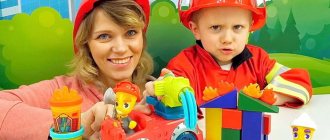Knitted attributes for role-playing games and theater
- 1 March 2013
Competition "Golden Handicraft - 2012"
Nomination "Magic Needle"
I love to knit and crochet. Beanies are my weakness.
There are many masks and hats on the Internet that can be printed, glued to cardboard and covered with tape. You can draw, or you can buy ready-made masks or hats. Fortunately, there is now no shortage of anything. But the process itself... It’s very interesting: what will happen as a result.
Crocheting a hat usually starts from the top of the head, with the first small round row. Further work will depend on the selected model. The overall appearance of the finished product depends on how you start knitting the bottom. A novice needlewoman needs to master two main types of headdress tops - for a model with a rounded shape and with a flat bottom (beret, skullcap, hat).
Instructions
1. If you are new to making patterns, find a ready-made crochet hat pattern and check the required size. Start working on the headdress with 3 air loops. They need to be closed in a circle using a connecting post and six single crochets in a circle. In this case, the knitted fabric will be quite dense. 2. The beginning of a light hat with a mesh surface will be not three, but five loops; make three loops to lift to the next row and make twelve double crochets in a circle. 3. Continue knitting the bottom of the hat, adding six (if you knit in single crochets) or twelve (if you do double crochets) stitches in each circular row. Do not forget to perform lifting loops when moving to the next row. 4. To get a flat bottom of a hat (for example, for a beret), increase stitches in this order. First, divide the bottom of the headdress into six (twelve) identical wedges (according to the number of initial columns), then add a column at the end of each row. To do this, two new ones are knitted from the bow of the lower column at once. This way you will make the top of the headdress the right size. 5. Try to start knitting a rounded hat. For it, you need to make a circle with a diameter of about eight to ten centimeters in circular rows. 6. This will be followed by gradual, uniform decreases in the columns - the product will begin to round out. At the beginning or middle of every second circular row, do not knit 6-7 stitches. 7. When the beginning of the headdress - its bottom - is knitted, continue working according to the pattern of a specific model. 8. I knit the ears, noses, eyes, cheeks, and tie them to the hat with a crochet hook.
Now for free use by children. Knitted hats will not wrinkle or tear like paper ones. They are very easy to wash. Children use them in theatrical and story games, as well as in outdoor games. With the help of these hats you can easily transform into a little lady or some other animal.
Application: Presentation.
Author: Nettina Marianna Ivanovna, teacher, second qualification category, MKDOU kindergarten “Bunny”, Tegi village, Khanty-Mansi Autonomous Okrug-Yugra. Work experience more than 10 years.
Technological map of the role-playing game “Introduction to the profession of an actor”
Technological map of the role-playing game
Subject:
“Introducing preschoolers to the profession of
actor
” (based on a fairy tale)
Age category
: middle preschool age
Compiled by
: teacher Romacheva Yu.V.
SOD form
: role-playing game
Form of organization:
group
Facilities:
Visual:
chairs, tables, cash register, paper money, display case, candy, cakes, juice bags, flowers, baskets for
flowers, bell, masks (mouse, frog, hare, fox, wolf, bear), little house, trees, screen. Literary:
Russian folk tale “Teremok” (in a new way).
Target:
Introducing children to the profession of actor.
Tasks:
Form ideas about the theater. Arouse interest in theatrical activities, a desire to perform together
with a group of peers.
Educational:
Develop a culture of behavior in public places, use polite words in speech.
Educational:
Learn to convey expressively the images of fairy tale characters in speech. Improve your ability to create for
the planned plot and game setting. Teach children to assign roles with the help of an adult, select
attributes corresponding to the plot-role-playing game and the roles of children; learn to negotiate with each other in the process
games.
Educational:
Develop creative abilities through theatrical art. Develop children's expressiveness
intonation, facial expressions, movements.
Stages of activity
Contents of activity
Actions, activities of the teacher
Activities and actions of children that will lead to the achievement of planned results
Planned result
Motivation
Creating an environment in the group for the development of a role-playing game.
The teacher invites several children to visit the theater.
The children agree with the teacher. They talk about how they went to the puppet theater.
The children agreed to perform a role-playing game.
Introduction to the topic of activity
Choosing a familiar fairy tale.
Educator: Guys, I suggest you act out a familiar fairy tale yourself. What fairy tale do you know well?
Let's remember this fairy tale. The teacher pays attention to the character of the characters and asks the children to describe them.
Children choose the fairy tale “Teremok”, which they have learned in advance.
They rehearse their lines, conveying the character and habits of their hero.
The children repeated a familiar fairy tale.
Activity stage
Conversation about theaters.
Preparing for the performance.
The teacher helps the children develop the game.
Educator: There are different theaters: puppet, opera, drama, ballet theater. What kind of theater will you have?
In order for visitors to attend the performance, what needs to be done? Where can I find out about the show?
Have you prepared your tickets? Have you posted a poster?
Who in the theater will take care that the audience is comfortable, fun and even tasty?
Who is the most important person in the theater? Who brings joy to children?
Educator: Guys, now you will show the fairy tale “Teremok”. First you need to assign roles, prepare the scenery, and prepare for the performance yourself.
The bell rings.
Children: we will have a dramatic one - where the roles are played by the people themselves.
You need to purchase tickets in advance and make a poster.
Yes. Children “hang up” a poster announcing the performance. Spectators are invited to purchase tickets for the performance (the “ticket sale” plot).
Ticketer, cashier, barmaid, actors.
Artists, actors.
Children assign roles, set up screens for the towers and trees. The cashier opens the box office and sells tickets, spectators buy tickets.
Spectators come to the performance, the usher checks the tickets.
Children actors act out a fairy tale.
The children listed the types of theaters. We got acquainted with the profession of an actor. We prepared and sold tickets, rehearsed our roles. They showed the performance.
The final stage. conclusions
Discussion of what was seen.
Educator: Do you think your game turned out well?
Were you interested?
Did the actors perform well?
Did you find binoculars useful while watching?
Were the actors and the audience grateful? How did they express their gratitude?
I think you made a wonderful game.
Yes.
Very.
Children evaluate the actors' performance.
They came in handy.
The audience was grateful and there was applause.
The actors and spectators were satisfied with the organized game. At the end of the event, children play the game independently.
Project of role-playing game "Theater" with children of the preparatory group
- I. Management tasks:
- Expand children's understanding of theater, its educational and social significance. To consolidate children's knowledge about the theater troupe and its workers, to show the collective nature of work in the theater.
- Exercise the ability to creatively develop the plot of the game, the ability to equip a place for the game. Strengthen the ability to distribute roles, as well as the ability to take on various roles in accordance with the plot of the game ; select and use attributes and building materials.
- develop the ability to negotiate, yield, persuade, develop a story from personal experience;
Develop dialogical communication, the ability to listen, speak out proactively, respond to the interlocutor’s statements, ask questions, and take turns in conversations.
Form a friendly relationship between children. Foster a culture of behavior in public places. II . Preparing for the game:
1) preparation plan for the game “Theater”
| date | Making attributes | Enrichment with impressions | Game action training |
| September | Making posters, tickets, money. | Conversations with children on the topic: “What did I see in the theater?”, “What kind of theater is there?”, “Why do you need a playbill in the theater?”, “Why do you need tickets in the theater?”, “Who works in the theater? Who is the artist, cashier, make-up artist, theater director, etc.?”, “Why is there a curtain in the theater? " | Through a game plot, teach children 1. the ethics of seating in the auditorium, 2. how an usher will greet spectators in the hall, how to behave during intermission 3. how to present flowers to artists and greet them beautifully. |
| Making flowers from paper for “artists”. | Examination of illustrations in books, folders and posters on the topic “Theatre”, “Who works in the theatre”, “Karabas Barabas Theatre”. | Learn how to make paper flowers for artists. Teach children how to correctly act out dialogues with the cashier, controller, dresser, and audience; | |
| Making programs for spectators. | Viewing by children of the CD “Virtual Journey through the Theater”; Presentations on the topic "Theater". Musical and didactic game “We went to the theater”; Game "Let's Play Spectators" Sketches “Buying a ticket to the theater”, “Today we are going to the theater”, | Teach children to make posters. Programs and tickets, decorations for a fairy tale. , | |
| Making signs – “Cash desk”, “Dressing room”, “ theater ”, scenery for a fairy tale | Dramatization “We are artists”; “The costume and make-up artist prepares the artist to go on stage.” Word game “What audiences love, what artists love.” Reading fiction: B. Zhitkov “What I Saw” (chapters from the story); S.Marshak “In the theater for children”; Reading poems - S. Marshak “In the Theater ”, A. Barto “In the Theater ”, Reading A. A. Tolstoy’s story “The Golden Key” Didactic games: “Auction of polite words”, “Pick up who needs what for work”, | Learn how to make sweets and salt dough cakes for the Buffet. | |
| Making numbers for the dressing room, seat numbers and rows, | Excursion to the State House of Culture in Kinel to the Theater Festival “Magic Curtain” for the production of the play “Karabas Barabas in Search of Happiness” |
2)
| Subjects | Roles | Attributes | Game actions | Speech figures |
| Theater. | Director. | Ppr Concert program. | Conducts a rehearsal, monitors the order in which the artists appear on stage | I ask all artists to come on stage |
| Entertainer | Leads Microphone | Leads the concert, announces the numbers | Good afternoon dear viewers! We are glad to welcome you to this wonderful hall! Today our artists will show the wonderful fairy tale “Karabas Barabas and his theater!” | |
| Dresser | Artists' costumes, wigs, attributes. | Selects costumes for actors in accordance with their role | Now let's check your costumes. Don't forget to take a pen with you. magic wand, etc. | |
| Artists | Microphone, attributes. | They put on costumes and play the role. | Speech based on the text of a fairy tale. | |
| Cashier | Tickets. Cash register, money cash machine. | Sells tickets, gives change. | We buy tickets. Here's your ticket and change. Row 1 place 5" | |
| Usher | Theater tickets indicating the row and seat number, form, theater program. | The usher accepts tickets, escorts spectators to their seats, offers programs, and answers questions. | Hello! - We are glad to see you in our theater! -Please take your seats. - Thank you! — Please take the program. | |
| Related stories | ||||
| Theater | Driver. | Steering wheel | Drives the bus | I ask all passengers to take their seats and fasten their seat belts. |
| Theater director | Folder with documents | Hires people and keeps order. Conducts meetings and meetings with spectators | Hello! What kind of work do you want to get in our theater? What can you do? We will be glad to see you, come again | |
| Barmaid | Sign “Buffet, money, food (cakes, chocolates, juices, candies), apron, doll dishes (cups, teapot, saucers, tray). | Arranges products, sets up displays, sells drinks, sweets, accepts money. | What do you want to buy? — Try this cake, is it delicious? - Thank you for your purchase. - Please! - Here's your order. | |
| Flower girl. | Flowers, money. | Sells flowers. | Buy flowers to give to artists. Thank you for your purchase! | |
III. Progress of the game
The phone rings. The teacher picks up the phone, “talks,” then addresses the children:
- Guys, just now the director of the theater called me and invited us to the theater of fairy tales and performances.
— Do you want to become real theater artists now and show a performance?
— I suggest you go to the magical world of the theater on a chartered bus, which will carry only us. (Driver-children-teacher)
- What do you think of, what can we do with our free time before the performance starts? (go to the buffet, drink juice, eat ice cream, cake, sit in the lobby, look at magazines). After the third bell, the doors to the auditorium close and the performance begins.
The teacher’s role is secondary, he is an observer: he includes music for songs and dances when necessary.
Conspiracy to play
After listening to musical fragments, the plot plan should be determined.
— Children-artists come to the director of the theater, distribute roles among themselves as desired, the teacher observes and advises; if a conflict situation arises regarding the choice of a character or you need to advise to come to an agreement or use a counting rhyme or a draw with emoticons of the characters from the fairy tale “The Golden Key”; - creating an imaginary situation; — full equipment, determination of the place for the game; — agree, plan and discuss the actions of all players.
Children play according to their own game plan
Techniques for maintaining and developing the game
- after the performance is over, the teacher joins the game as a producer who invites the children to go to the performance at the Kinelsky State House of Culture.
Techniques for forming relationships in the game
— Remind about polite relationships, attention to each other;
— Help children agree and act together if difficulties arise;
- Encourage children.
IV End of the game
The teacher informs the children that it is time for the artists to return to their theater, and for the audience to return to the group, since their parents will soon come for them.
V. Game Evaluation
The teacher asks the children if you liked the game. Do you think you coped with the roles? What was difficult for you to deal with in the game. Was it difficult to cope with the role? Why? Whose performance did you like best? Who was the most expressive? Children, you are great!



